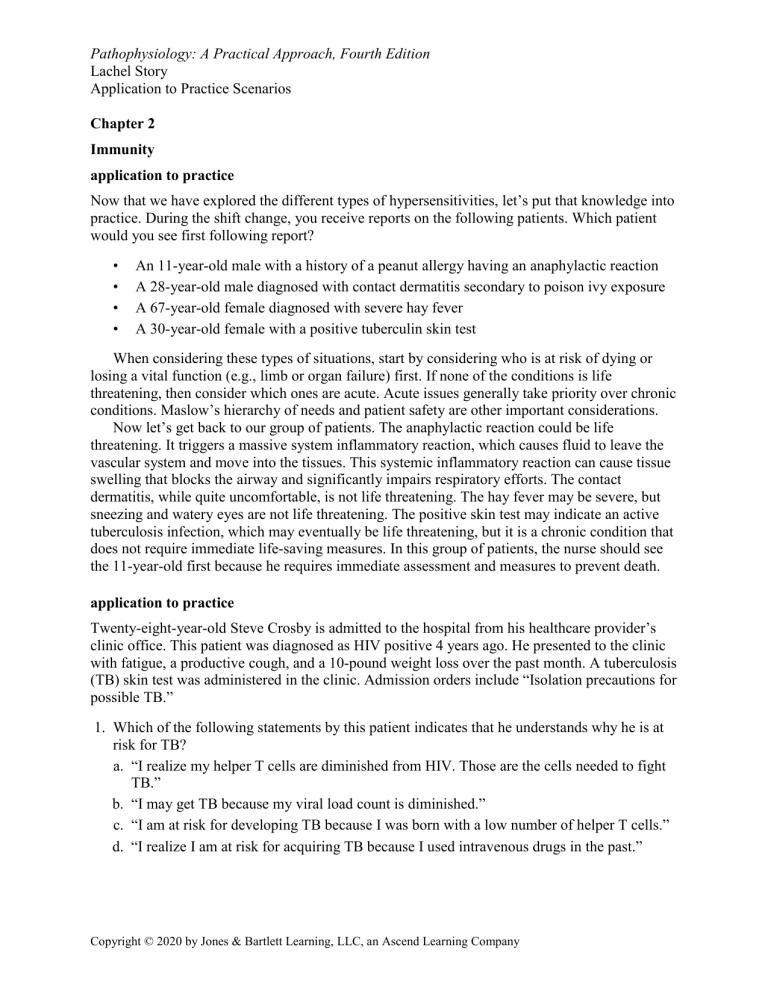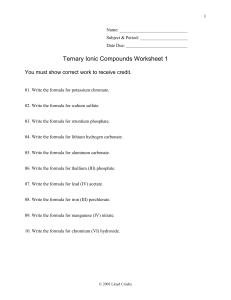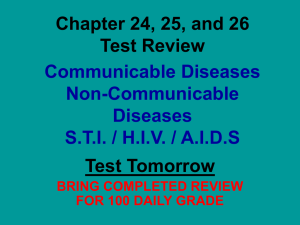
Pathophysiology: A Practical Approach, Fourth Edition Lachel Story Application to Practice Scenarios Chapter 2 Immunity application to practice Now that we have explored the different types of hypersensitivities, let’s put that knowledge into practice. During the shift change, you receive reports on the following patients. Which patient would you see first following report? • • • • An 11-year-old male with a history of a peanut allergy having an anaphylactic reaction A 28-year-old male diagnosed with contact dermatitis secondary to poison ivy exposure A 67-year-old female diagnosed with severe hay fever A 30-year-old female with a positive tuberculin skin test When considering these types of situations, start by considering who is at risk of dying or losing a vital function (e.g., limb or organ failure) first. If none of the conditions is life threatening, then consider which ones are acute. Acute issues generally take priority over chronic conditions. Maslow’s hierarchy of needs and patient safety are other important considerations. Now let’s get back to our group of patients. The anaphylactic reaction could be life threatening. It triggers a massive system inflammatory reaction, which causes fluid to leave the vascular system and move into the tissues. This systemic inflammatory reaction can cause tissue swelling that blocks the airway and significantly impairs respiratory efforts. The contact dermatitis, while quite uncomfortable, is not life threatening. The hay fever may be severe, but sneezing and watery eyes are not life threatening. The positive skin test may indicate an active tuberculosis infection, which may eventually be life threatening, but it is a chronic condition that does not require immediate life-saving measures. In this group of patients, the nurse should see the 11-year-old first because he requires immediate assessment and measures to prevent death. application to practice Twenty-eight-year-old Steve Crosby is admitted to the hospital from his healthcare provider’s clinic office. This patient was diagnosed as HIV positive 4 years ago. He presented to the clinic with fatigue, a productive cough, and a 10-pound weight loss over the past month. A tuberculosis (TB) skin test was administered in the clinic. Admission orders include “Isolation precautions for possible TB.” 1. Which of the following statements by this patient indicates that he understands why he is at risk for TB? a. “I realize my helper T cells are diminished from HIV. Those are the cells needed to fight TB.” b. “I may get TB because my viral load count is diminished.” c. “I am at risk for developing TB because I was born with a low number of helper T cells.” d. “I realize I am at risk for acquiring TB because I used intravenous drugs in the past.” Copyright © 2020 by Jones & Bartlett Learning, LLC, an Ascend Learning Company Pathophysiology: A Practical Approach, Fourth Edition Lachel Story Application to Practice Scenarios One of the unlicensed assistive personnel (UAP) caring for Mr. Crosby says, “Now that Mr. Crosby’s condition has worsened and he is symptomatic, shouldn’t added precautions be posted on his door to protect staff members?” 2. Which information should the nurse give the UAP? a. Reverse isolation precautions should be implemented to protect the staff. b. Respiratory precautions are all that are needed, and those are already posted on the door. c. Following standard precautions will minimize the exposure to blood and body fluids. d. Staff members caring for Mr. Crosby should begin prophylactic medications. 3. What should the nurse say to the UAP? a. “Wearing all that equipment is a waste of supplies, and we have already had budget cuts.” b. “Can you tell me what you are getting ready to do?” c. “Don’t you know all that equipment is not necessary?” d. “Wearing all that equipment may frighten Mr. Crosby.” It is important that Mr. Crosby understand how to prevent the spreading of HIV before he is discharged home. When discussing infection control practices with the nurse, Mr. Crosby says, “I have heard that condoms don’t always prevent HIV.” 4. How should the nurse respond? a. “Where do you usually get your health information?” b. “I will have an AIDS educator come discuss condom use with you.” c. “I know you would feel terrible if you gave someone HIV because you didn’t use a condom.” d. “If used properly and regularly, latex condoms are highly effective in preventing HIV transmission.” application to practice Let’s put the things you have learned about the body’s defenses into practice. Which of the following individuals would be at highest risk for impaired immune function? • • • • A 23-year-old female who weighs 5% more than her ideal body weight A 78-year-old male with poorly controlled diabetes mellitus An 89-year-old male with controlled hypertension A 45-year-old female who was recently widowed When considering this type of question, you start by counting things that might impair the immune system. The patient with the most risk factors is at the greatest risk. Eliminate any information that does not increase risk. For instance, being male or female does not impair immune function, so eliminate that factor from your consideration. Let’s look at each of the example patients. The 23-year-old is not in an older age range and is fairly close to her ideal body weight; she has no risk factors. The 78-year-old is assigned one risk Copyright © 2020 by Jones & Bartlett Learning, LLC, an Ascend Learning Company Pathophysiology: A Practical Approach, Fourth Edition Lachel Story Application to Practice Scenarios factor for his increased age and another for his chronic disease. Go ahead and give him another risk factor because his diabetes is uncontrolled—now he has three risk factors. The 89-year-old has one risk factor for his increased age and another for having a chronic disease, but his hypertension is controlled. He has two risk factors. Finally, the 45-year-old has only one risk factor, the stress of being recently widowed. After examining all of these patients, the 78-yearold male is at the most risk for impaired immune function owing to his three risk factors. At-risk individuals and states that specifically put individuals at risk for an impaired immune system include the following: • • • • • • • • • • • Very young or very old age Poor nutrition Impaired skin integrity Circulatory issues Alterations in normal flora due to antibiotic therapy Chronic diseases, especially diabetes mellitus Corticosteroid therapy Chemotherapy Smoking Alcohol consumption Immunodeficiency states The following strategies can be employed to build a healthy immune system: • • • • • • • Increasing fluid intake Eating a well-balanced diet Increasing antioxidants and protein intake Getting adequate sleep Avoiding caffeine and refined sugar Spending time outdoors Reducing stress Copyright © 2020 by Jones & Bartlett Learning, LLC, an Ascend Learning Company


